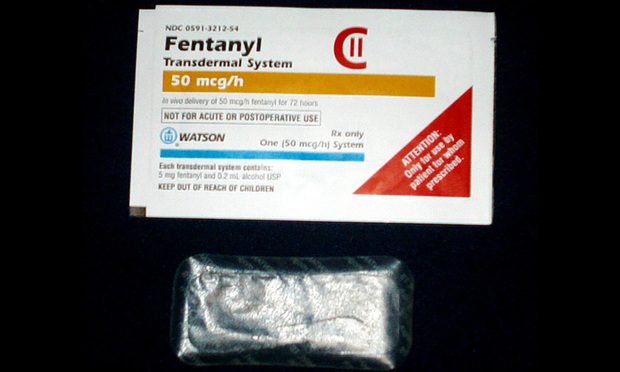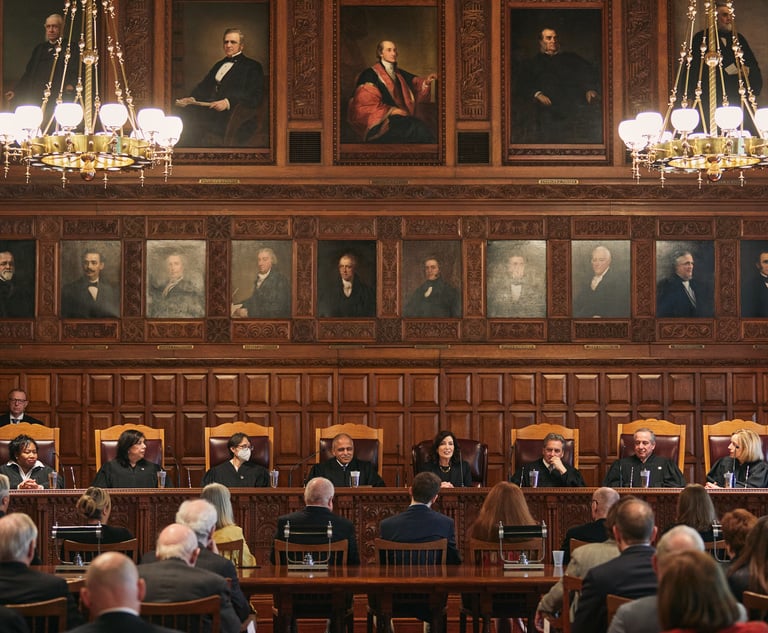Latest Efforts to Curb Opioid Epidemic in NY: Controlled Substance Schedule Changes
Under a 30-day budget amendment that Gov. Andrew Cuomo recently announced, 11 fentanyl analogs will be added to the state controlled substances schedule and the New York health commissioner will have the authority to add to the state controlled substances list new drugs that are added to the federal schedule.
February 09, 2018 at 03:23 PM
3 minute read
 Fentanyl Transdermal System patch. Photo: Wikimedia Commons
Fentanyl Transdermal System patch. Photo: Wikimedia Commons The New York state health commissioner will have the authority to add to the state controlled substances list new drugs that are added to the federal schedule, under a 30-day budget amendment that Gov. Andrew Cuomo recently announced.
The move also will add 11 fentanyl analogs, which are drugs that are substantially similar to fentanyl, to the state controlled substances schedule—actions that, according to the governor, will support law enforcement's efforts to stop the spread of lethal drug abuse in New York.
“Make no mistake: Fentanyl is potent, dangerous and its abuse is increasingly fueling the misery of the opioid epidemic,” Cuomo said in a news release. “These actions will give law enforcement the tools they need to combat this drug, holding the death dealers who peddle it accountable and helping ensure that our laws are able to keep pace with this evolving public health crisis.” The release from the Department of Financial Services, which regulates banks and insurance companies in the state, helps close a loophole in state law that left the 11 fentanyl analogs off the controlled substances schedule.
The U.S. Drug Enforcement Administration last November said it also would classify fentanyl analogs in the same category with heroin.
According to the U.S. Centers for Disease Control and Prevention, fentanyl is a synthetic opioid 50 to 100 times more potent than morphine that typically is used to treat advanced cancer pain and prescribed in the form of skin patches or lozenges. Illegally made fentanyl, often mixed with heroin or cocaine, has been increasingly abused in the United States and linked to most fentanyl-related overdoses and death, the CDC said.
In New York, fentanyl analogs increasingly have been found pressed into pill form to resemble name-brand prescription opioids, and in heroin and cocaine sold in the state, according to the state Department of Health. A preliminary analysis conducted by the agency identified more than 2,900 opioid-related deaths among state residents in 2016. Staten Island saw a 700 percent increase in overdose deaths involving fentanyl—from seven deaths in 2015 to 58 deaths last year—while statewide, the number of fentanyl-related deaths increased by nearly 160 percent in 2016.
The 11 dangerous fentanyl analogs added to the state controlled substances list will be scheduled as Class I, the most highly regulated types of prescription drugs. Current Class I scheduled substances in New York include opiates such as codeine and heroin, hallucinogenic substances such as ecstasy and LSD, and stimulants such as cocaine and methamphetamine.
Certifying that the state health commissioner may add to the state controlled substances schedule any new drugs that have been added to the federal schedule allows the state to regulate the substances more vigorously.
These two new actions are the latest in Cuomo's institution of policies designed to continue the state's fight to end its prescription opioid and heroin addiction epidemic. Past measures include limiting initial opioid prescriptions for acute pain from 30 to seven days and expanding insurance coverage for substance abuse treatment.
This content has been archived. It is available through our partners, LexisNexis® and Bloomberg Law.
To view this content, please continue to their sites.
Not a Lexis Subscriber?
Subscribe Now
Not a Bloomberg Law Subscriber?
Subscribe Now
NOT FOR REPRINT
© 2025 ALM Global, LLC, All Rights Reserved. Request academic re-use from www.copyright.com. All other uses, submit a request to [email protected]. For more information visit Asset & Logo Licensing.
You Might Like
View All
Tensions Run High at Final Hearing Before Manhattan Congestion Pricing Takes Effect
4 minute read
Lisa Zornberg, Former Adams Chief Counsel, Moves to Morvillo Abramowitz
5 minute readTrending Stories
Who Got The Work
Michael G. Bongiorno, Andrew Scott Dulberg and Elizabeth E. Driscoll from Wilmer Cutler Pickering Hale and Dorr have stepped in to represent Symbotic Inc., an A.I.-enabled technology platform that focuses on increasing supply chain efficiency, and other defendants in a pending shareholder derivative lawsuit. The case, filed Oct. 2 in Massachusetts District Court by the Brown Law Firm on behalf of Stephen Austen, accuses certain officers and directors of misleading investors in regard to Symbotic's potential for margin growth by failing to disclose that the company was not equipped to timely deploy its systems or manage expenses through project delays. The case, assigned to U.S. District Judge Nathaniel M. Gorton, is 1:24-cv-12522, Austen v. Cohen et al.
Who Got The Work
Edmund Polubinski and Marie Killmond of Davis Polk & Wardwell have entered appearances for data platform software development company MongoDB and other defendants in a pending shareholder derivative lawsuit. The action, filed Oct. 7 in New York Southern District Court by the Brown Law Firm, accuses the company's directors and/or officers of falsely expressing confidence in the company’s restructuring of its sales incentive plan and downplaying the severity of decreases in its upfront commitments. The case is 1:24-cv-07594, Roy v. Ittycheria et al.
Who Got The Work
Amy O. Bruchs and Kurt F. Ellison of Michael Best & Friedrich have entered appearances for Epic Systems Corp. in a pending employment discrimination lawsuit. The suit was filed Sept. 7 in Wisconsin Western District Court by Levine Eisberner LLC and Siri & Glimstad on behalf of a project manager who claims that he was wrongfully terminated after applying for a religious exemption to the defendant's COVID-19 vaccine mandate. The case, assigned to U.S. Magistrate Judge Anita Marie Boor, is 3:24-cv-00630, Secker, Nathan v. Epic Systems Corporation.
Who Got The Work
David X. Sullivan, Thomas J. Finn and Gregory A. Hall from McCarter & English have entered appearances for Sunrun Installation Services in a pending civil rights lawsuit. The complaint was filed Sept. 4 in Connecticut District Court by attorney Robert M. Berke on behalf of former employee George Edward Steins, who was arrested and charged with employing an unregistered home improvement salesperson. The complaint alleges that had Sunrun informed the Connecticut Department of Consumer Protection that the plaintiff's employment had ended in 2017 and that he no longer held Sunrun's home improvement contractor license, he would not have been hit with charges, which were dismissed in May 2024. The case, assigned to U.S. District Judge Jeffrey A. Meyer, is 3:24-cv-01423, Steins v. Sunrun, Inc. et al.
Who Got The Work
Greenberg Traurig shareholder Joshua L. Raskin has entered an appearance for boohoo.com UK Ltd. in a pending patent infringement lawsuit. The suit, filed Sept. 3 in Texas Eastern District Court by Rozier Hardt McDonough on behalf of Alto Dynamics, asserts five patents related to an online shopping platform. The case, assigned to U.S. District Judge Rodney Gilstrap, is 2:24-cv-00719, Alto Dynamics, LLC v. boohoo.com UK Limited.
Featured Firms
Law Offices of Gary Martin Hays & Associates, P.C.
(470) 294-1674
Law Offices of Mark E. Salomone
(857) 444-6468
Smith & Hassler
(713) 739-1250








